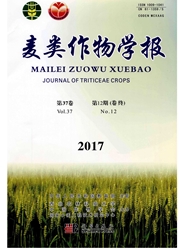

 中文摘要:
中文摘要:
为筛选冬小麦高产高效优化种植管理模式,2009-2010年在河南省温县高产区大田试验条件下,分析了当前传统农民习惯模式(CP)、调整模式1(AP1)和调整模式2(AP2)3种种植管理模式下冬小麦干物质和氮素累积转运及籽粒产量的差异。结果表明,不同生育时期种植管理模式间小麦干物质积累均存在差异,CP和AP1拔节前干物质积累量显著高于AP2,拔节至成熟AP2则显著高于其他模式。营养器官花前贮藏干物质花后向穗部的转移量占总穗重的34.15%~50.84%,氮转移量占穗增长量的77.92%~85.07%,与CP和AP2相比,AP1显著提高了花后干物质和氮素累积对穗部的贡献率。AP1、AP2籽粒产量比CP分别提高11.72%和25.82%,穗粒数和千粒重增加是其增产的主要原因。植株总吸氮量、籽粒吸氮量及收获指数以AP2最高,氮肥利用率和产投比则以AP1最高。综合比较不同模式的籽粒产量、氮肥利用率和产投比,AP1可作为当前小麦高产高效生产的最佳种植管理模式。
 英文摘要:
英文摘要:
In order to explore the optimization cultivation management mode and achieve the high tar- get yield and resource efficiency in winter wheat, three cultivation management modes including the current pattern of traditional farmers used (CP), the adjustment pattern 1 (AP1) and the adjustment pattern 2 (AP2) were conducted to study the influence of different cultivation management modes on grain yield, nitrogen efficiency and ratio of output to input under the conditions of field experiment in Wen County of Henan Province during 2009--2010. The results showed that there were different in dry matter accumulation dynamics at different stages for different modes, dry matter accumulation in CP and AP1 were higher than other modes at before jointing stage, AP2 was significantly higher than other modes at post-jointing stage to maturity. The transfer accounts of the dry matter stored in vege- tative organs between before-anthesis and post-anthesis occupied 34.15 % -50.84 % of the ear weight for different cultivation management models , and the nitrogen transference accounted for 77.92%- 85.07% of the quantity of ear increment. AP1 increased the contributions of in dry matter and nitro- gen post-anthesis to ear compared with CP and AP2. Compare with CP, grain yield in APland AP2 in- creased by 11.72% and 24.45%, respectively. There were more spikes in CP, but grain number per spike and grain weight were significantly lower than other models. AP2 was the highest in total a- mounts of plant nitrogen absorption, grain nitrogen absorption and harvest index~ P1 was the highest in nitrogen use efficiency and ratio of output to input. Comprehensive comparison among grain yield, nitrogen use efficiency and the ratio of output to input of different models, AP1 was the optimized cul- tivation management models, and could be a cultivated management model in current wheat produc- tion.
 同期刊论文项目
同期刊论文项目
 同项目期刊论文
同项目期刊论文
 期刊信息
期刊信息
